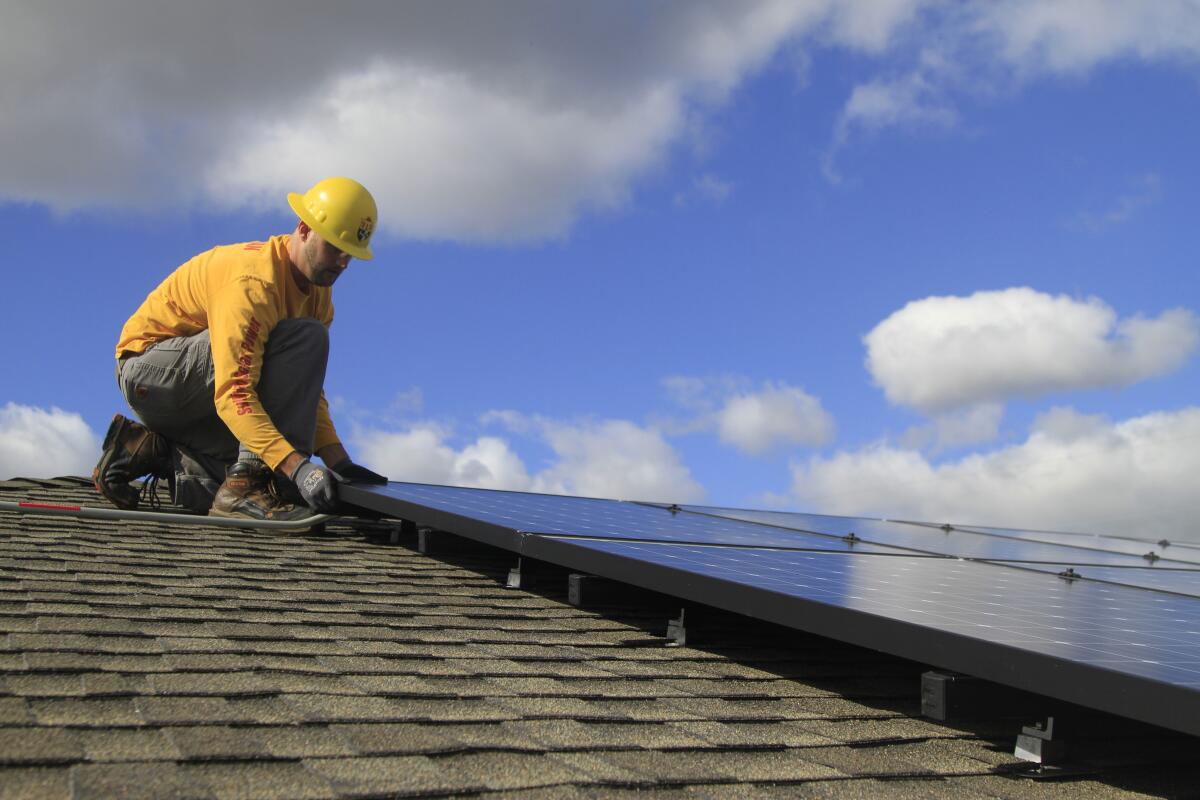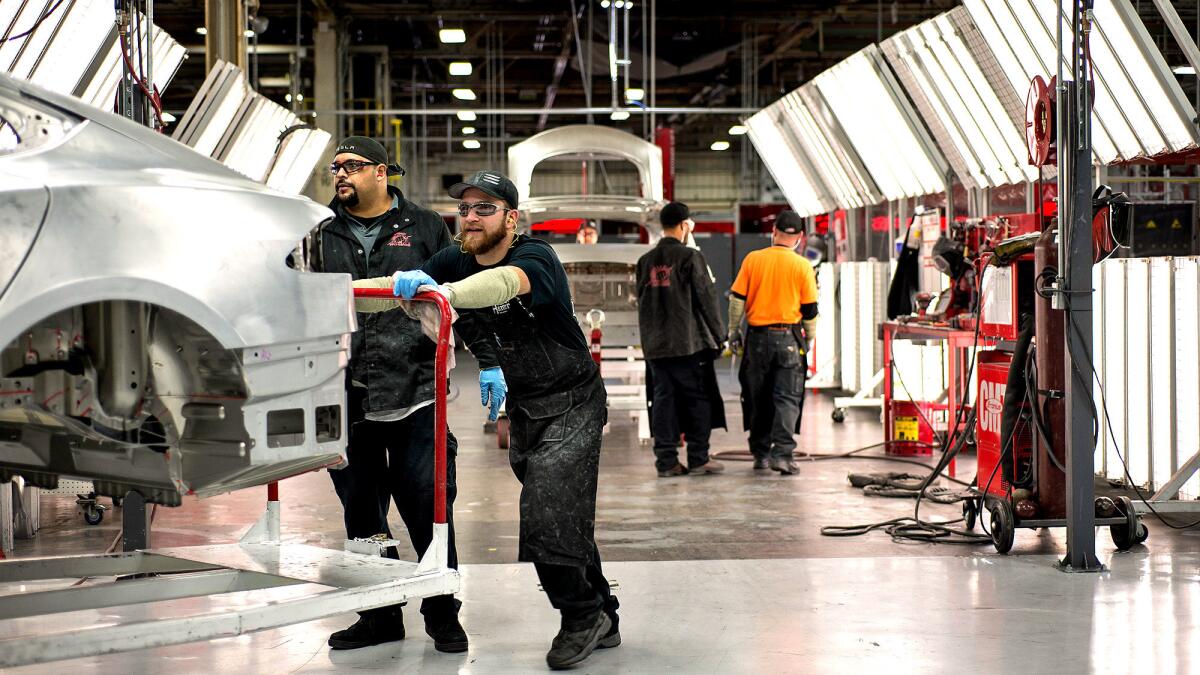Clean energy jobs are coming. Here’s how to make sure they’re good jobs

Joe Biden said at the Democratic National Convention that America should “lead the world in clean energy and create millions of new good-paying jobs.” Similar thinking underlies the Green New Deal, which declares a goal of “guaranteeing a job with a family-sustaining wage, adequate family and medical leave, paid vacations, and retirement security to all people of the United States.”
So how do we actually create those kinds of family-supporting jobs, and give people the skills to fill them?
That’s the subject of a report released today by UC Berkeley’s Center for Labor Research and Education. It was commissioned by the California Legislature, and at 636 pages it’s an extremely thorough guidebook for policies the state might employ.
But don’t call it a “green jobs” report.
Carol Zabin, a UC Berkeley labor economist and the report’s lead author, told me it’s more accurate to talk about “greening” existing jobs rather than creating entirely new “green jobs.” The difference, she said, is that many of the workers who will build and install the clean energy technologies of the future — such as solar panels, electric cars and efficient lighting — are already in the energy workforce. They might need new training, but the fundamental skill sets are the same. An electrician is an electrician.
“I give the example of an auto mechanic on an electric vehicle,” Zabin said. “Yes, they’re different. They’re different in terms of the powertrain and all that. But the wheels and the bumper and the windshield wiper systems, those are pretty much the same.”
Toward a more sustainable California
Get Boiling Point, our newsletter exploring climate change, energy and the environment, and become part of the conversation — and the solution.
You may occasionally receive promotional content from the Los Angeles Times.
Another key point in the report is that well-intentioned climate policies don’t necessarily create good jobs.
Zabin pointed to a divide in the renewable energy industry, in which union jobs building large solar farms typically pay better and offer stronger benefits than non-union jobs installing rooftop solar panels.
Alternately, take clean transportation. Workers at two electric bus manufacturers with factories in California, BYD and ProTerra, have unionized in recent years. But Elon Musk’s Tesla Inc. has taken an anti-union stance and been accused of unsafe working conditions at electric vehicle factories in California and Nevada, most recently defying a COVID-19 shutdown order by reopening its Fremont facility and reportedly firing workers who elected to stay home.
None of this is to say rooftop solar panels and electric cars aren’t valuable to the people who buy them, or to society as a whole. But Zabin thinks government should craft climate policies that encourage employers in those industries and others to offer high-paying jobs with benefits, make those jobs accessible to non-white workers, and sponsor apprenticeship programs that allow for career advancement.
“Are we creating good jobs, or are we creating lousy jobs like we tend to in the California economy?” Zabin asked.

One way or another, these types of jobs are coming into existence. Before the COVID-19 pandemic, California had 537,000 clean energy workers, according to an analysis by the advocacy group Environmental Entrepreneurs. And that number is certain to rise as the state targets 100% climate-friendly electricity and a carbon-neutral economy by mid-century.
So what does the UC Berkeley report recommend? Lots of stuff! It’s 636 pages long. Here are a few high-level ideas:
- Public funds should come with strings attached. Companies getting government- or ratepayer-funded contracts to build clean energy infrastructure, such as electric vehicle chargers or public transit systems, could be required to hire from disadvantaged communities, offer state-certified apprenticeship programs and verify their compliance with labor laws.
- Government should partner with industry to fund training programs. The goal should be “comprehensive training that prepares workers for careers, rather than niche programs that train on one particular ‘green’ skill or ‘green’ technology that may become outdated as technology advances,” the report says.
- Make sure teachers have the clean energy knowledge they need. Instructors at community colleges and apprenticeship programs must be prepared to educate a new generation of workers. State government can help by supporting curriculum upgrades and offering professional development opportunities.
If there’s one place the report is relatively sparse on details, it’s the section on ensuring a “just transition” for fossil fuel workers. The main recommendation is further study, with a focus on diversifying regional economies that depend on single industries.
This is an especially hot topic in Appalachia and other parts of coal country, where jobs have been disappearing for decades. But it’s poised to become a pressing issue in California, where jobs drilling for oil in the San Joaquin Valley and building gas pipelines to serve new homes may begin drying up as the state continues to reduce emissions.
“Moving someone from an oil refinery in L.A. to some parallel clean energy job is often not realistic,” Zabin said.
The future of the natural gas workforce may be an especially tough knot for California to untie, in part because Southern California Gas Co., the nation’s largest gas utility, is aggressively fighting efforts to phase out gas for heating and cooking.
The state’s Public Utilities Commission is evaluating strategies for managing the transition away from gas, including implications for utility workers. So is the think tank Gridworks, through a study process that has included SoCalGas and other gas utilities.
The group released a report last year recommending steps such as buyout programs for older workers, ratepayer-funded retraining programs, wage protections for people assigned to new responsibilities, and internal placement programs for workers at dual-fuel utilities such as Pacific Gas & Electric, where the electric side of the business might grow as the gas side shrinks.
Gridworks is planning to outline more detailed ideas in the coming months,
“We’re trying to create a situation where people who now have good jobs can be supportive of a transition, because they will still have good jobs,” said Marc Joseph, an attorney who represents the Coalition of California Utility Employees.
Finally, it’s worth remembering that organized labor can play a key role in shaping climate policy.
Some unions have embraced the Green New Deal and its emphasis on high-quality jobs. But others are skeptical. I reported last year that a union of Los Angeles utility employees temporarily blocked approval of a record-cheap solar power contract in part due to frustration over the city’s plan to shutter gas-fired power plants. And I reported this year that the leader of a SoCalGas union threatened to spread COVID-19 in response to a city government proposal to promote all-electric buildings.
Organized labor is a powerful force in California, and in the Democratic Party nationally. So union support could be the difference between passing ambitious climate action and allowing the climate crisis to keep getting worse.
“When unions feel like they see their future in a clean economy, and they really have evidence at hand...they tend to be supportive, because most of them are not climate deniers,” Zabin said.”But like all of us, union members who fear their basic livelihood is going to get lost, they call up their elected leaders and say, ‘Hey, your job is to protect us.’”
And now, here’s what else is happening around the West:
TOP STORIES
I wrote last year that California faced a crossroads on the path to 100% clean energy as it grappled with the future of gas-fired power plants. For better or for worse, the state took its first step on that road this week, choosing to keep operating four gas-fired power plants along the coast near Los Angeles past the end of this year, as I reported for The Times. Last month’s rolling blackouts, resulting from power shortages during a heat wave, partially motivated the decision by the State Water Resources Control Board. (By the way, my colleague Paul Duginski warns you should get ready for more extreme heat this weekend.)

California would be hopelessly overmatched without thousands of inmate firefighters, who are paid slave wages to do the grunt work of battling fires. Now a bill approved by lawmakers would “right one of California’s most notorious wrongs,” as Times columnist Erika D. Smith writes: the fact that former inmates are barred from firefighting jobs once they leave prison. Here’s Erika’s story on Assembly Bill 2147, which is supported by the Los Angeles Lakers and awaits Gov. Gavin Newsom’s signature.
Our Houston bureau chief, Molly Hennessy-Fiske, has been covering the destruction wrought by Hurricane Laura. Here’s Molly’s piece on the storm’s arrival in Louisiana, which knocked out power to hundreds of thousands of households. Molly also wrote about people who chose not to evacuate out of fear they would contract COVID-19. And in case you’re wondering, yes, the hurricane was supercharged by climate change, as Chris Mooney and Andrew Freedman report for the Washington Post.
CALIFORNIA BURNING
The state’s biggest blazes are increasingly contained, but it’s no time to get complacent. Even though lightning was largely responsible for the fires, my colleague Joseph Serna reports that climate change made it easier for the flames to spread as fast and as far as they did — and the world keeps getting hotter. Another thing not to get complacent about? Our own responsibility to avoid accidental ignitions. The Times’ Louis Sahagun spent the night with Forest Service rangers patrolling for illegal campfires.
As fire burns nearby, activists are sneaking into Point Reyes National Seashore to bring water to tule elk. Activists say the elk are dying from dehydration and can’t access other water sources because of a fence meant to protect cattle ranches; the National Park Service not only says the elk are fine, it’s considering killing some to protect the ranches, as Susanne Rust and Anita Chabria report for The Times. This story grapples with tough questions about when humans should intervene on behalf of wildlife.

After refusing to evacuate, Noah Standridge protected his home from fire with a water-filled flower pot. Please understand I am not recommending this; as Susanne Rust writes in her story on Santa Cruz Mountains residents who defied evacuation orders, refusing to evacuate can endanger firefighters who might be forced to come rescue you. For more practical advice, The Times’ Rachel Schnalzer wrote about steps you can take to make sure you have adequate insurance and are prepared to flee.
Enjoying this newsletter? Consider subscribing to The Times
Your support helps us deliver the news that matters most, and makes newsletters like Boiling Point possible. Become a Los Angeles Times subscriber.
POLITICAL CLIMATE
The California Legislature ended its 2020 session with zero additional action on wildfires. Democratic lawmakers dropped a last-minute proposal to spend $3 billion on emergency fire response and long-term prevention, replacing it with a more modest $500-million plan, as my colleague Taryn Luna reported. But even that proposal couldn’t overcome legislative hurdles.
Another proposal that didn’t make the cut in Sacramento: tough restrictions on single-use plastics. Here’s the story from Rachel Becker at CalMatters, who notes that the bill “fell four Assembly votes shy of passing as many Democrats sat out the vote.” But the University of California’s 10 campuses are phasing out single-use plastics, as Joshua Emerson Smith reports for the San Diego Union-Tribune. And state lawmakers did vote to phase out firefighting foam containing PFAS — toxic chemicals that have been linked to cancer and which, like plastics, have contaminated water supplies, as Anna M. Phillips reports for The Times.
California has now sued the Trump administration 100 times. More than half of those lawsuits deal with environmental rules, and No. 100 is no exception. The Times’ Patrick McGreevey talked with the state’s attorney general, Xavier Becerra, about the latest suit, which alleges the Trump administration has undermined the National Environmental Policy Act by weakening legally mandated environmental assessments and limiting the public’s ability to review federal actions.
POWER STRUGGLES
Diesel trucks and cargo ships will be required to slash emissions dramatically under rules approved by the California Air Resources Board. My colleague Tony Barboza reports that the new regulation “will be crucial in reducing smog and cancer risk to millions of Californians who, despite years of gradual improvement, still breathe the nation’s worst-polluted air.” Depending on how quickly it’s implemented, the regulation could also help reduce COVID-19 mortality; new research finds that higher exposure to nitrogen dioxide pollution is associated with higher death rates from the virus, as Sean Reilly reports for E&E News.
The California Public Utilities Commission fired its executive director. This is a complicated and still evolving story, but here’s the first draft of history, from Rob Nikolewski at the San Diego Union-Tribune. The short version is the commissioners claim Alice Stebbins made a handful of questionable hires; Stebbins says she’s being retaliated against for her tough scrutiny of companies the agency regulates. Her attorneys uncovered hundreds of text messages showing the commissioners had private discussions about firing her, possibly in violation of the state’s open meetings law, as Jeff McDonald reports for the Union-Tribune.
You’ve heard of the Tesla Model 3, but what about the Polestar 2? The Times’ Russ Mitchell took a spin in this new Swedish/Chinese-made car, and he says it’s “one of the very best driving electric vehicles on the market right now.”
What do you want to know?
When you think about California’s climate future, what comes to mind? What keeps you up at night, and what gives you hope or gets you excited? What do you want to understand, and what should I?
This newsletter is for you, to help you understand how we’re changing our world and what we can do about it, and I want to hear your questions, concerns and ideas. Email me or find me on Twitter.
ONE MORE THING
I took a few days off this week, driving to the Bay Area to visit friends and family (with proper social distancing.) I always enjoy passing by notable energy infrastructure when I’m on the move, and this trip offered plenty of opportunities. I saw wind turbines in the Altamont Pass while driving on Interstate 580; the Chevron oil refinery as I strolled through Miller/Knox Regional Shoreline; and Marin Clean Energy’s 60-acre Solar One facility, built on a former landfill, as I drove the wrong direction out of Richmond.
On my way back home, I stopped at Harris Ranch, along Interstate 5 in the San Joaquin Valley. As I breathed in the powerful aroma of cow manure, I noticed that two new electric vehicle charging stations had been added to the fleet of Tesla chargers:
Energy: It’s everywhere.
I’ll be back in your inbox next week. If you enjoyed this newsletter, please consider forwarding it to your friends and colleagues.




